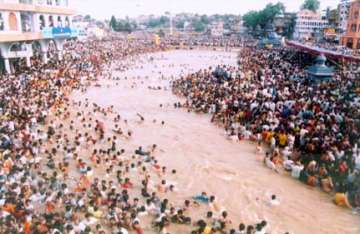Maha Kumbh Starts, Over 10 Lakh Take Dip In Ganga
Braving bone-biting chill, over 10 lakh devotees on Thursday took a holy dip in the freezing waters of the Ganga here heralding the start of the three- month-long Maha Kumbh, the world's largest religious congregation

Braving bone-biting chill, over 10 lakh devotees on Thursday took a holy dip in the freezing waters of the Ganga here heralding the start of the three- month-long Maha Kumbh, the world's largest religious congregation that takes place once in 12 years.
As the sun rose at about 0645 hours, hordes of pilgrims and sadhus, who had lined up along the streets of Haridwar, started their dips at various ghats along the river whose sacred waters they believe will wash away their sins.
The bath taken today on the occasion of 'Makar Sankranti' marks the first of the 11 key dates for holy dips which will fall over the next three months ending April 28. Makar Sankranti, also known as Uttarayan, is a day when the sun starts to move northwards marking the decline of winter.
Men, women and children outnumbered the sadhus, who are expected to throng the temple town only after January 26 as the official entrance of the 'akharas' (Hindu religious orders) will begin then.
The first 'shahi snan' or the royal bath is scheduled for February 12 when akhara chiefs will take the dip. They will be led by ash-smeared Naga sadhus, who are Lord Shiva devotees.
"Over 10 lakh pilgrims have taken bath in the Ganga since early this morning till late afternoon," Chief Mela Officer Anand Bardhan told PTI.
The other key dates for the baths are January 15 (Mauni Amavasya and solar eclipse), January 20 (Basant Panchami), January 30 (Magh Purnima), February 12 (Maha Shivaratri), March 15 (Somvati Amavasya), March 16 (Nvasamvatsar), March 24 (Rama Navami), March 30 (Chaitra Purnima), April 14 (Mesh Sankranti) and April 28 (Baishakh Adimasaha Purnima).
Many foreigners also took bath at the 'Hari-ki-Pauri' and other ghats in this holy town, keen to share the spiritual experience.
Under the watchful eyes of hordes of policemen, the devotees have been pouring into Haridwar in cars, buses, tractor-trolleys and trains from all over the country for purification of soul.
The roads leading to nearly 300 ghats have a heavy police presence that has turned the Haridwar into a fortress. Barricades have been set up to control the flow of crowds. The traffic in the city has come to a halt with no vehicles being allowed to ply.
People with folded hands and a prayer on their lips walked along the roads as the ghats echoed with Vedic hymns, bells and conch shells, leaving an enchanting spell.
"I was in Jaipur where I was told about this mega religious event. I came down to be a part of it," said Victor Schendia from Switzerland, who lined up near Hari Ki Pauri.
Vijai Raj Shankar Sharma, a devotee from Uttar Pradesh, said, "It is something that I always wanted to do. I never got a chance but now I have closed my business till February 12 and have come here with my family. The water is very cold but I am happy that I undertook this journey." The district administration said their aim is to give at least five minutes to each devotee to take his bath.
The Kumbh Mela goes back to the Vedic ages. According to Hindu mythology, the four places where Kumbh is observed are the ones where four drops of 'amrit' (nectar) fell from the 'kumbh' (pot) when Lord Vishnu's 'vahan' (vehicle) 'Garuda' was escaping from the demons who also wanted the nectar. Belief is that the river Ganga also acquires certain properties of the nectar during Kumbh.
Instructions about safety arrangements were given out on the public address systems, which have have been set up all across Haridwar town.
"We have kept blankets, boats and made arrangements for bonfire in case any of the devotee taking the bath suffers from hypothermia. Steps are all in place to ensure that any needy person is taken to the hospital fast," Chief Mela Officer Bardhan said.
Spread over an area of 130 sq km, the Kumbh has been divided into 12 zones and 32 sectors. Thirty-four police stations and 42 makeshift posts have been set up besides the 36 temporary fire stations.
Cars bearing Delhi registration plates and packed with people could be seen speeding down the NH-72, connecting Dehradun and Haridwar with the national capital.
"We left at about six in the morning and reached here by about 10:30 am. We are originally from Haridwar and hence could not miss taking a dip in the Kumbh. We plan to come here on all 'snan' (bath) days," said Hari Shankar Mishra, a real estate dealer in the national capital.
Many of the families have also hired taxis and mini vans, who are all parked in the two-storeyed parking bay constructed near the main ghat to cater those from outside.
Meanwhile, top environmentalists led by Chipko movement leader Sunderlal Bahuguna gathered here to launch a campaign to save the river Ganga and the Himalayas.
In Prayag, thousands of devotees lined up to take a holy dip at the holy Triveni Sangam, the confluence of rivers Ganga, Yamuna and the mythical Saraswati which does not exist any more.
Thousands more took a holy dip at the Brahma sarovar in Kurukshetra, Haryana, the place where the epical battle between Kauravas and Pandavas was fought several thousand years ago.
Hundreds of pilgrims took a holy dip at the famous ghat of Varanasi on Thursday morning to herald Makar Sankranti. Since a solar eclipse is expected on Friday, devotees have been asked to complete their holy dip by Thursday evening.
Thousands of devotees congregated at the Sethani Ghat near Hoshangabad to take a dip in the holy river Narmada.